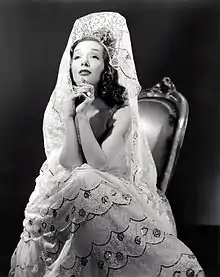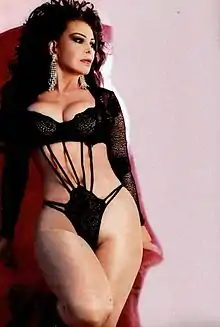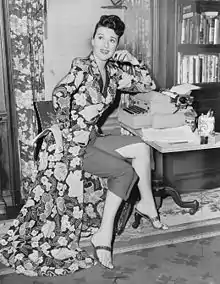Vedette (cabaret)
A vedette is the main female artist of a show derived from cabaret and its subcategories of revue, vaudeville, music hall or burlesque. The purpose of the vedette is to entertain and captivate the public. The vedette has to know how to sing, dance and act on stage. Particularly accomplished artistes are considered super vedettes or first vedettes. Vedettes often appear alongside groups of dancers, flashy and revealing costumes, magicians, comedians, jugglers, or even performing animals. Vedettes specializing in burlesque generally do striptease and may also perform nude on stage.
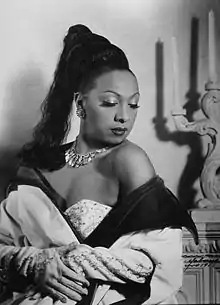
In the 20th century, vedette shows were successful in the cabarets, theaters and nightclubs of countries such as Spain, France, Argentina and Mexico. Paris and Las Vegas were considered the main cradle of the vedettes.
Etymology
Vedette is a French word originally used to designate an artist of great fame and notoriety.[1] The term underwent changes over the years. From the early twentieth century, it began to be used to designate the main female artists of the shows of a cabaret such as burlesque, vaudeville, music hall or revue. The zenith of fame and popularity of these women coincided with various historical moments of 20th century sexual liberation: the 1920s, 1940s and 1970s.
The vedettes began their rise in popularity in France at the beginning of the 20th century. After France, they have gained greater popularity in Latin countries, both in Europe (Spain) and North and South America (Argentina and Mexico), where they caused a furor in the nightlife at different times. The term is little used in English-speaking countries, although in the United States there are very popular shows of cabaret and burlesque in Las Vegas, where it is often confused with showgirls. Venues such as Le Lido, the Moulin Rouge, and the Crazy Horse in France, the Teatro Maipo and the Teatro El Nacional in Argentina, and the Teatro de la Ciudad "Esperanza Iris" in Mexico are or were famous for their vedette shows.
Europe
France

France is considered the cradle of vedettes worldwide. Its capital, Paris, has been home to some of the most famous cabarets in the world. Among these are the Moulin Rouge and the Folies Bergère de Paris, pioneers of night shows in which the vedettes appeared on the scene half naked and doing Tableau vivant. Other famous venues are the Le Lido and Bataclan, also famous for their vaudeville and revues. In more recent times, the Crazy Horse also became a notable cabaret.
Famous French vedettes included the "Three Graces" of the Belle Époque: Émilienne d'Alençon, Liane de Pougy, and La Bella Otero.[2] The famous Mistinguett became one of the most popular French artists of her time[3] while Madame Rasimi is remembered as the founder of the Bataclan. Another outstanding figure was Gina Palerme.
At the beginning of the 20th century, the novelist Colette also performed in revue. Another prominent figure of that time was the world-famous Dutch spy Mata Hari. The legendary Cléo de Mérode of the Folies Bergère was another of the great stars.[4]
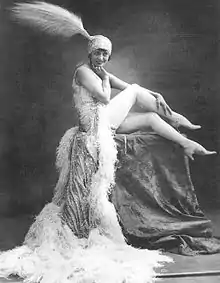
Joséphine Baker,[5] of American origin, is remembered as one of the most important vedettes. Her "Revue Nègre", which included a jazz orchestra, caused a sensation. Her exotic dance form, her uninhibited sexuality and her minimal dress (which included a skirt made of bananas) were more attractive to Europeans than to Americans. She became the star of Parisian nights and even opened her own club, Chez Josephine.
Another important figure was Coccinelle, considered the first transgender vedette in history.[6] The actress and singer Liliane Montevecchi stood out as vedette in the Folies Bergère in the 1970s, and eventually conquered Broadway. Another figure of the time was the Italian Xenia Monty.
In recent times the vedette shows have emphasized figures like Arielle Dombasle (known as the vedette-like Dolorès Sugar Rose) and Marlène Mourreau.
Spain
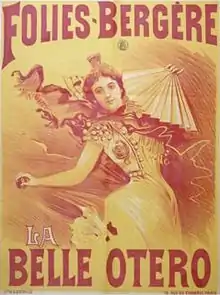
One of the first vedettes that stood out in Spain are La Bella Otero, a celebrated courtesan who settled in France, one of the most outstanding personages of the Belle Époque in the artistic circles and the gallant life of Paris;[7] Luisa Esteso, famous comedian actress; Encarnación Fernández, who had most of her career in Argentina;[8] Celia Gámez (of Argentine origin), one of the most popular stars of Spain in the first half of the twentieth century, and who owes much of the splendor of the Revues;[9] Paquita Garzón;[10] Rosario Guerrero (called "The Beautiful Guerrero"); Rosita Rodrigo; Tina de Jarque,[11] Rosario Soler "La Patita",[12] Paquita Escribano, Carmen Tórtola Valencia, specialist in oriental dances and pioneer of women's liberation,[13] and the sisters Laura and Victoria Pinillos.[14]
The 1940s highlighted figures such as Trini Alonso, María Antinea (also famous in Argentina and Mexico); Maruja Boldoba, Florinda Chico, Gema del Rio, the popular Manolita Chen and her company; Teresita Silva; Maruja Tomás and Helga Liné.[15]
The 1950s highlighted stars like Mary Begoña, one of the comedic actresses par excellence of the Spanish scene;[16] Licia Calderón, Queta Claver (that became one of the major vedettes of Spain);[17] Raquel Daina;[18] Marujita Díaz, considered as the "Queen of the Copla" and "Queen of the Spanish Music Revue" and Carmen de Lirio, famous during the dictatorship.[19]
In the sixties, famous figures such as Mary Santpere, called "La Reina del Paralelo" (The Queen of the Parallel) reached the fame of Barcelona's homonymous street, where the greatest number of theaters were concentrated in the 20th century; Rosita Amores, pioneer of the erotic cabaret in the mid-1960s, and who knew how to outwit Franco's censorship in times when eroticism in Spain was confined to the private sphere, becoming a popular symbol of entertainment in the Valencian Community; Marisol Ayuso; Ingrid Garbo, of German origin; Vicky Lagos; Vicky Lusson; Katia Loritz;[20] Esperanza Roy, and Lina Morgan, one of the country's most momentous comic strips.[21] Sara Montiel, deserves special mention, who along with her prestigious film career, excelled in shows as a vedette from this decade.
In the 1970s María José Cantudo starred in the first full-length female nude (seen through a mirror) of Spanish cinema;[22] Eva León Conde[23] and Barbara Rey were also popular vedettes of the period.
From the 1980s and 1990s stand out figures such as Lita Claver "La Maña";[24] Norma Duval, one of the last stars of the traditional magazine, a type of spectacle that during those years was in decline and that was maintained mainly thanks to the tourists who visited Paris;[25] Tania Doris, another one of the last representatives of the sort in Spain ; Paloma Hurtado, María José Nieto "Maripepa",[26] Rosa Valenty, Africa Pratt and the French Marlène Mourreau.[27]
In the last years they have emphasized figures like La Terremoto de Alcorcón and the transsexual actresses ´Bibiana Fernandez, La Veneno and La Prohibida.
The Americas
Argentina
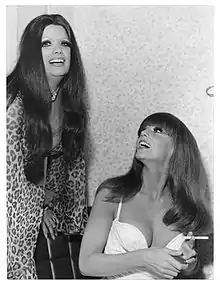
Revue shows were popularized in Buenos Aires from the 1920s, mainly in the Teatro Maipo.[28] Tita Merello became one of the most famous vedettes of the time.[29]
In the 1950s vedettes of Cuban origin appeared, like Blanquita Amaro[30] Amelia Vargas[31] and Rosita Fornés.[32] They had all the glitz, grace and glamor that characterized the era, and shared the stage with local stars like Nélida Roca.[33]
In the 1960s appeared figures like Zulma Faiad,[34] Nélida Lobato,[35] Susana Brunetti, Norma Pons, Egle Martín[36] and the Puerto Rican Iris Chacón, called the "Vedette of America".[37]
The 1970s and 1980s gave way to other stars like Graciela Alfano[38] and the sisters Ethel and Gogó Rojo.[39] Others who arose at that time and remained in force in the following years were Susana Giménez[40] Moria Casán[41] and Bettina Vardé.[42] and the men-vedette Jorge Perez Evelyn.[43]
In the 1990s, new vedettes appeared, some of whose fame would spread to the next decade, such as Cris Miró,[44] María Fernanda Callejón, the Puerto Rican Lourdes Chacón[45][46][47] and Monica Ayos.[48]
In the first years of the 21st century there is a return of the revues in the Avenida Corrientes with figures like Florencia de la V,[49] María Eugenia Ritó,[50] Adabel Guerrero,[51] and Valeria Archimó.[52]
Mexico
The image of the Vedette in Mexico arises from the beginning of the 20th century with the rise of the called "Carpas" and the Revues. Some venues such as Teatro Principal,[53] the Teatro Colón[54] and the Teatro Arbeu[55] were considered as the cathedral of the revues and burlesque in Mexico City. There arise figures like Lupe Vélez, who, before being consecrated as a star in Hollywood, was considered one of the queens of the frivolous theater.[56] The maximum figure of the time was Maria Conesa "The White Kitten", who also had a very long career spanning theater, film and television.[57] Other outstanding figures of the time were Esperanza Iris,[58] Celia Montalván,[59] Lupe Rivas Cacho,[60] Amparo Arozamena,[61] Prudencia Grifell,[62] Celia Padilla,[63] Delia Magaña,[64] Lupe Inclán, Aurora Walker, Amelia Wilhelmy[65] and Mimí Derba,[66] among others. Conesa, Montalván and Rivas Cacho, were even immortalized in a famous foxtrot called Mi querido capitán (My dear captain).
In the 1950s[67] saw a resurgence of nightlife in Mexico City. Venues like the Tivoli, the Waikikí, the Margo (after the Teatro Blanquita), the Follies Bergere and the Teatro Lírico,[68] among others, became the main forums for the blossoming of the vedettes. Special mention should be made of the Exoticas, a group of vedettes that caused fury in Mexico's nightlife in the late 1940s and early 1950s. These "Exoticas" were characterized by using extravagant names, and their shows included African, Tahitian or Oriental dances.[69] The most famous of the "Exoticas" was Yolanda Montes "Tongolele",[70] one of the most important dancers of Latin America, and has been in force for more than sixty years. Together with Tongolele, the most famous were Su Muy Key The Chinese Doll,[71] and Kalantan. Another famous "Exóticas" were Trudi Bora, Turanda, Joyce Cameron, Tanabonga, Tundra, Gemma, Eda Lorna, Kurumba, Bongala, Tula Montenegro, Brenda Conde, Josefina del Mar and Naná.[72] Parallel to the success of the Exoticas, they appear in Mexico the famous "Rumberas", dancers of Afro-American rhythms. The Rumberas managed to create their own cinematographic genre: The Rumberas film[73] In the called Golden Age of Mexican cinema. The Rumberas films reflected in many of its arguments the life of the women in the night centers and cabarets. The main exponents of the genre were the Cubans María Antonieta Pons,[74] Amalia Aguilar,[75] Ninón Sevilla[76] and Rosa Carmina[77] as well the Mexican Meche Barba.[78] These women were complete vedettes who never needed to explicitly teach their bodies, captivating audiences only with their dances and other stage talents. The Rumberas also performed shows and live performances in important venues. With the decline of the Rumberas film in the mid-fifties, some rumberas broadened their horizons and ventured into vedette shows. Particularly remembered are the live shows of Amalia Aguilar and Rosa Carmina, who even filled stadiums in various countries in Central and South America. The Cuban Rosita Fornés deserves special mention. She reaches the final consecration in Mexico before conquering the rest of the continent.[79]
In the 1960s the splendor of the vedettes in Mexico lost force. Even so, worthy of mention are the shows offered in venues such as the Blanquita Theater or "El Patio" by the stars such as Sonia Furió, Ana Luisa Peluffo[80] and Ana Bertha Lepe.[81] In the midst of the fury of the Rock and Roll era, were famous figures like Malú Reyes[82] and Emily Cranz.[83] Actresses such as Jacqueline Voltaire[84] and Irán Eory[85] also performed shows as vedettes.
The 1970s and 1980s are considered the golden era of the vedettes in Mexico, thanks to a massive revival of nightlife in the country's capital. Mexico City was flooded with nightclubs, cabarets of all levels and burlesque theaters where the vedettes began to bloom. Among the most important nightclubs that illuminated the capital of the country are the Terazza Casino, the Capri (from the Hotel Regis), the Imperial, the Minuet, the Rio Rosa, La Fuente, El Conjunto Marrakech, La Copa de Champagne, El Cordiale, El Rondinella, El Clóset, El Quid, El 77, the Impala Bar and the Belvedere of the Hilton Continental Hotel. Some cabarets such as La Burbuja, Montparnasse, Las Fabulosas, El Can-Can, Los Globos, King Kong and Savoy also reached a great boom, while theaters like El Iris, El Blanquita and the Teatro Fru Fru[86] presented burlesque shows, where the shows were more audacious and explicit. In addition, thanks to television, movies and magazines, the vedettes in Mexico reached their highest point of popularity. Many of them also ventured into the cinema, within the so-called Mexican sex comedy.[87] On the other hand, the popular television program Variedades de medianoche (Varieties of the Midnight) contributed to the boom of these women and launched to the fame to dozens of them.[88]
Among the legendary vedettes that illuminated the nightlife of Mexico City are Olga Breeskin also known as "Super Olga" who achieved great fame for her spectacular performances where she danced surrounded by dancers and exotic animals while playing the violin;[89] Angélica Chaín,[90] who achieved fame first in magazines, then start a career as a vedette and finally consecrate herself in the cinema; Amira Cruzat, famous for her show known as The Dressing Room of Amira Cruzat;[91] Lila Deneken "The Number One", important singer and the first Latin American star to present a show at the Monte-Carlo Sporting Club;[92] the Argentine Zulma Faiad who settled in Mexico much of the decade of the 1970s and reached a great fame in cinema and night centers;[93] Gloriella, popular star of the burlesque and numerous movies;[94] Princesa Lea,[95] very popular for presenting a show in which she bathed in a glass of champagne; Lyn May,[96] of Chinese ancestry, pioneer of the nudes and one of the principal stars of the burlesque; Rossy Mendoza,[97] known popularly as "The Body" or "The Shorter Waist", thanks to her impressive anatomy; Sasha Montenegro,[98] who on par of her film career performed live shows that attracted the public because of her popularity; The Brazilian Gina Montes, famous by her appearance in a popular TV Show;[99] Grace Renat, The Goddess of the Night,[91] Irma Serrano,[100] who scandalized at the time with her controversial theatrical spectacles in the enclosure of her property, the Theater Fru-Frú; Wanda Seux,[101] called "The Golden Bomb" and considered the "Barbie" of the vedettes for her thin figure and blonde hair; Thelma Tixou "The Girl of the Golden Body",[102] native of Argentina, famous for her stature and imposing physique, and star for several years of the famous cabaret El Capri, Isela Vega,[103] popular Mexican film actress, who scandalized audiences with her provocative shows in the stage, and Princesa Yamal,[104] famous by her Arabian exotic dances.
Other outstanding figures were Brigitte Aubé, Cleopatra,[105] Alejandra del Moral,[106] Mora Escudero,[107] Gioconda,[108] Ivonne Govea,[109] Iris Cristal,[110] Yolanda Liévana,[111] Norma Lee,[112] Mara Marú,[113] Miss Melina Mey,[114] Gina Morett, the transgender Jessica Muriel,[115] Valeria Pani,[116] Noelia Noel,[110] Gabriela Ríos,[117] Olga Ríos,[110] Lina Santos,[118] Merle Uribe[119] and Judith Velasco Herrera,[107] among many others.
In the year 2016, the filmmaker María José Cuevas made the documentary Beauties of the Night, which portrays the life of five of these great vedettes.[120]
One of the last great vedettes in Mexico was Francis García, a transvestite artist who was the main star of the Teatro Blanquita for more than a decade.[121] In recent years, large night centers have virtually disappeared from Mexico. Some actresses and singers perform shows of vedettes in other venues, such as the Palenques. Among them are figures such as Costa Rican Maribel Guardia,[122] Mexicans Lorena Herrera, Mariana Seoane,[123] the transgender Alejandra Bogue[124] and Ninel Conde and the Cubans Niurka Marcos[125] and Lis Vega.[126]
United States
The term "vedette" is not commonly used in the United States or other Anglo-Saxon countries, (here called "showgirls"). Las Vegas is considered, after Paris, as the main venue for revue shows and musicals worldwide.
The British Lydia Thompson became a leading dancer and actress in burlesques on the London stage. She introduced Victorian burlesque to America with her troupe the "British Blondes", in 1868, to great acclaim and notoriety.[127]
Of the most famous American vedettes, stand out May Yohé, one of the most valued figures of the vaudeville at the beginning of the century;[128] The aforementioned Josephine Baker, who ended up consecrating herself in France, where she was more popular than in her own country; Fanny Brice, star of the famous Ziegfeld Follies, queen of the theater, revues and later also star of cinema and the radio;[129] Sally Rand, actress and dancer, specializing in fan dancing, which she popularized at the Paramount Club, and who because of the postures considered indecent she adopted with the dance was sometimes arrested. Also conceived the famous dance of the bubble;[130] Zorita, famous for her shows where she played double roles and for her dances where she used boas and other exotic animals;[131] Evelyn West, also known as "The Hubba Hubba Girl", a burlesque legend of the forties, fifties and sixties;[132] Ann Corio, who also works in several Hollywood films;[133] Mae West, who achieved tremendous fame, first in theater and then in Hollywood, where she scandalized censorship for her provocative behavior and spicy phrases. In the 1950s and 1960s, she achieved fame in her shows, which included groups of dancers and bodybuilders;[134] Gypsy Rose Lee, immortalized in the famous autobiographical musical Gypsy. Her innovations consisted of a casual style, against the spasmodic movements of other strippers (she emphasized the joke during the striptease) and brought a keen sense of humor to her performances. She was one of the main stars of the Minsky's Burlesque, with whom she worked four years. Working with the Minsky brothers was arrested several times.[135] Another important figure of this time was Novita "The Pixie of Burlesque", one of the founders of the Exotic Dancers League (EDL).[136] In the 1940s and 1950s, the exotic dancer Lottie 'The Body' Graves also shone in the burlesque. She was known as "The Black Gypsy Rose Lee".[137] In the 1950s and 1960s Jennie Lee was considered one of the queens of burlesque.[138]
In the 1960s and 1970s some burlesque figures peaked in the United States, particularly at the shows offered in Las Vegas. Of these are highlighted Tempest Storm,[139] Lili St. Cyr,[140] Blaze Starr,[141] Kitten Natividad,[142] Tura Satana,[143] Bambi Jones[144] Princess Cheyenne,[145] Satan's Angel.[146]
The most important in recent years has been Liza Minnelli[147]
Today, among the most famous vedettes in the United States are Dita Von Teese, who was the star of Crazy Horse,[148] Julie Atlas Muz,[149] Michelle L'amour,[150] Catherine D'lish,[151] Miss Dirty Martini,[152] the British Immodesty Blaze,[153] Angie Pontani,[154] Jo Weldon[155] and the Singaporean Sukki Singapora, the first international burlesque artist in Singapore. Singapora became the first burlesque artist in the world to be invited to tea at Buckingham Palace as a recognition of her contribution to the arts as an Asian model.[156]
Other
Other prominent vedettes who have appeared in the world are the Puerto Rican Iris Chacón,[37] the Brazilian Luz del Fuego,[157] the Cubans Chelo Alonso and Rita Montaner,[158] the Peruvian Amparo Brambilla[159] and the Venezuelans Haydée Balza and Diosa Canales.[160]
Fiction
Film
- Lola-Lola in the film The Blue Angel (1930)
- Gypsy Rose Lee in the film Gypsy (1962)
- Sally Bowles in several works, notably the musical Cabaret (1966)
- Miss Piggy in The Muppet Show (1976)
- Jessica Rabbit in the film Who Framed Roger Rabbit (1988)
- Satine in the film Moulin Rouge! (2001)
- Roxie Hart in the film Chicago (2002)
See also
References
- "Le Dictionnaire - Définition vedette". www.le-dictionnaire.com. Retrieved 2 July 2018.
- "The Courtesan". 14 September 2011. Retrieved 2 July 2018.
- "Biografia de Mistinguett". www.biografiasyvidas.com. Retrieved 2 July 2018.
- "Biografía insólita. Cleo de Mérode, la bailarina más deseada". www.portalsolidario.net. Retrieved 2 July 2018.
- "Biography - The Official Licensing Website of Josephine Baker". Retrieved 2 July 2018.
- "Biography of Coccinelle in her official web page". Archived from the original on 28 December 2016. Retrieved 2 July 2018.
- "La Bella Otero - Álbum de mulleres - culturagalega.org". www.culturagalega.org. Retrieved 2 July 2018.
- "Teatro Maipo". 6 October 2014. Archived from the original on 6 October 2014. Retrieved 2 July 2018.
- "The Career of Celia Gámez". Archived from the original on 27 March 2008. Retrieved 2 July 2018.
- "Hemeroteca de ABC - abc.es". hemeroteca.abc.es. Retrieved 2 July 2018.
- "El misterio de la vedette Tina de Jarque". Retrieved 2 July 2018.
- "Rosario Soler. La Patita. Biografía de la tiple malagueña". Rosario Soler. La Patita. Biografía de la tiple malagueña. Retrieved 2 July 2018.
- "Tórtola Valencia: entre la danza y el deseo". 31 January 2016. Retrieved 2 July 2018.
- "ABC (Madrid) - 04/11/1970, p. 93 - ABC.es Hemeroteca". hemeroteca.abc.es. Retrieved 2 July 2018.
- "Teresita Silva". lazarzuela.webcindario.com. Retrieved 2 July 2018.
- "HISTORIAS DE LA REVISTA MUSICAL ESPAÑOLA". Retrieved 2 July 2018.
- "elmundo.es - Fallece la actriz Queta Claver, una de las vedettes más populares". www.elmundo.es. Retrieved 2 July 2018.
- Madridiario. "Raquel Daina: superviviente de la pasarela". Retrieved 2 July 2018.
- SL, DiCom Medios. "Gran Enciclopedia Aragonesa Online". www.enciclopedia-aragonesa.com. Retrieved 2 July 2018.
- "Muere la actriz Katia Loritz, una de las 'Chicas de la Cruz Roja'". Retrieved 2 July 2018.
- "Article about Lina Morgan". Retrieved 2 July 2018.
- "Blanco y Negro (Madrid) - 03/01/1976, p. 51 - ABC.es Hemeroteca". hemeroteca.abc.es. Retrieved 2 July 2018.
- "Eva León - Biografía de Eva León". www.biografias.es. Retrieved 2 July 2018.
- "LITA CLAVER "LA MAÑA"". 19 January 2010. Retrieved 2 July 2018.
- Mx.Hola.com; Hola.com. "Norma Duval. Noticias, fotos y biografía de Norma Duval". mx.hola.com. Retrieved 2 July 2018.
- "HISTORIAS DE LA REVISTA MUSICAL ESPAÑOLA". larevistamusical.blogspot.mx. Retrieved 2 July 2018.
- "Official biography of Marlène Mourreau(in French)". Archived from the original on 2012-01-12. Retrieved 2 July 2018.
- "La catedral de la revista". Retrieved 2 July 2018.
- Article about Tita Merello in La Nación
- Reporter, Tango (25 July 2009). "TANGO Reporter: Blanquita Amaro, la bailarina cubana que entre rumbas y tangos triunfo en la Argentina". Retrieved 2 July 2018.
- "Conceptical". 18 August 2014. Archived from the original on 18 August 2014. Retrieved 2 July 2018.
- Rosita Fornés Official page
- "Nélida Roca: adiós a un mito porteño". Retrieved 2 July 2018.
- "Zulma Faiad". IMDb. Retrieved 2 July 2018.
- "Nélida Lobato, una vedette como ya no hay". Retrieved 2 July 2018.
- "Página/12 :: las12". www.pagina12.com.ar. Retrieved 2 July 2018.
- "Iris Chacón". Retrieved 2 July 2018.
- "Graciela Alfano: "Me encanta que me crean mala"". Retrieved 2 July 2018.
- Clarín.com. "Ethel y Gogo Rojo". Retrieved 2 July 2018.
- "Susana Giménez ". 3 November 2011. Archived from the original on 3 November 2011. Retrieved 2 July 2018.
- "Revista Gente". Infobae. Retrieved 2 July 2018.
- Mariano. "Vardé, Bettina". www.nuestrosactores.com.ar. Retrieved 2 July 2018.
- "Jorge Perez Evelyn". Retrieved 2 November 2017.
- Clarín.com. "Murió Cris Miró, una figura de la revista". Retrieved 2 July 2018.
- "Article in Spanish:The Vedette doesn't die: They transform". Primera Hora. 2011-03-05. Retrieved 2017-03-25.
- "Article: La Vedette Revelación del 1981-1982". Lourdes Chacón. 2017-02-23. Retrieved 2017-03-25.
- "Article: Vedette of the decade: "Golden Owl" Award. (Premio Búho de Oro)". Lourdes Chacón. 2017-02-20. Retrieved 2017-03-25.
- Clarín.com. "Mónica Ayos: "Toda la vida me gustaron los desafíos"". Retrieved 2 July 2018.
- "Article about Florencia de la V". Archived from the original on 2015-10-25. Retrieved 2017-01-04.
- "Biography of María Eugenia Ritó". Archived from the original on 5 March 2016. Retrieved 2 July 2018.
- "HugeDomains.com - AdabelGuerrero.com is for sale (Adabel Guerrero)". www.adabelguerrero.com. Archived from the original on 7 July 2011. Retrieved 2 July 2018. Cite uses generic title (help)
- "Article about Valeria Archimó". Archived from the original on 2016-03-30. Retrieved 2017-01-04.
- "Historia del Teatro Principal en México 1753-1931 - Museo EBC". museoebc.org. Retrieved 2 July 2018.
- Clarín.com. "El Teatro Colón, en el D.F. de México". Retrieved 2 July 2018.
- "EL TEATRO ARBEU - Ciudadanos en Red". 2 July 2009. Retrieved 2 July 2018.
- "Martín Caballero presenta su 'biopic' sobre Lupe Vélez". Retrieved 2 July 2018.
- Acuña, Roberto (8 August 2011). "María Conesa: La artista, la mujer y el mito". Retrieved 2 July 2018.
- "Biografia de Esperanza Iris". www.biografiasyvidas.com. Retrieved 2 July 2018.
- "Las tiples y el cine mudo". 14 October 2009. Retrieved 2 July 2018.
- "LUPE RIVAS CACHO". Retrieved 2 July 2018.
- "El Universal - - Perfil: María Amparo Arozamena Sánchez". www.eluniversal.com.mx. Retrieved 2 July 2018.
- "about Prudencia Griffel". Retrieved 2 July 2018.
- "TEATRO MEXICANO". Pinterest. Retrieved 2 July 2018.
- "Museo CJV". www.museocjv.com. Retrieved 2 July 2018.
- "Reliquias Ideológicas: W". 1 April 2010. Retrieved 2 July 2018.
- "Article about Mimí Derba". Archived from the original on 2013-12-13. Retrieved 2 July 2018.
- 20Minutos (2011-06-24). "Los últimos cabarets mexicanos". Retrieved 2 July 2018.
- "Article about the Teatro Lírico". Archived from the original on 2017-10-03. Retrieved 2 July 2018.
- Llano, Gabriela Pulido (1 October 2013). "Tongolele y las "exóticas" en Magazine de Policía y VEA". Diario de Campo (13): 32–36. Archived from the original on 2018-07-02. Retrieved 2 July 2018 – via www.revistas.inah.gob.mx.
- Calle, Tommy. "Perfume de Gardenia arranca gira en LA". Retrieved 2 July 2018.
- Morales, Miguel Angel (1 May 2010). "Bitácora: SU-MUY-KEY". Retrieved 2 July 2018.
- "Por esto Yucatán: The Amazing World of the Exoticas". Retrieved 2 July 2018.
- "1946-1950: Rumberas y Arrabal". cinemexicano.mty.itesm.mx. Archived from the original on 2012-02-22. Retrieved 2 July 2018.
- "María Antonieta Pons". IMDb. Retrieved 2 July 2018.
- "Amalia Aguilar - Beginnings". www.amaliaaguilar.com. Retrieved 2 July 2018.
- Espectáculos (2 January 2015). "Ninón Sevilla". Retrieved 2 July 2018.
- "El Rincón de la Añoranza". Retrieved 2 July 2018.
- López, René Muñoz (1 September 2008). "El Rincón de la Añoranza: LAS RUMBERAS parte 4: LA RUMBERA MEXICANA... MECHE BARBA". Retrieved 2 July 2018.
- "Rosita Fornés". cinemexicano.mty.itesm.mx. Archived from the original on 2013-07-04. Retrieved 2 July 2018.
- "Por esto Yucatán: Ana Luisa Peluffo". Retrieved 2 July 2018.
- "Article about Ana Bertha Lepe". Archived from the original on 17 November 2010. Retrieved 2 July 2018.
- "Malu Reyes - Vuelve Primavera: El rock de los 60 en México". estroncio90.typepad.com. Retrieved 2 July 2018.
- "Emily Cranz". www.venamimundo.com. Retrieved 2 July 2018.
- "ArtículoSiete.com: The A Go go Girls". Archived from the original on 5 March 2017. Retrieved 2 July 2018.
- "Iran Eory Z'L, Leyenda del Cine y la Televisión Mexicana - Diario Judío: Diario de la Vida Judía en México y el Mundo". diariojudio.com. 2015-02-10. Retrieved 2 July 2018.
- Cinefagia, Revista. "Tívoli - revistacinefagia.com". www.revistacinefagia.com. Retrieved 2 July 2018.
- "1976-1982: Los años de las "Ficheras"". cinemexicano.mty.itesm.mx. Archived from the original on 2013-08-01. Retrieved 2 July 2018.
- "Cinematerapia: Variedades de Medianoche". Archived from the original on 2017-11-06. Retrieved 2 July 2018.
- "Olga Breeskin - DurangoMas". 23 October 2013. Retrieved 2 July 2018.
- Web, © Sarpanet, Diseño. "Angelica Chain - Biografía, fotos, palmarés, vídeos -". www.sarpanet.info. Retrieved 2 July 2018.
- México, El Universal, Compañia Periodística Nacional. "¿Qué hacen hoy las vedettes de los años 70?". Retrieved 2 July 2018.
- "Recordando a Lila Deneken". 20 February 2011. Retrieved 2 July 2018.
- Web, © Sarpanet, Diseño. "Zulma Faiad - Biografía, fotos, palmarés, vídeos -". www.sarpanet.info. Retrieved 2 July 2018.
- Cinefagia.com: Article about Gloriella
- Acero, Los Jinetes De (13 July 2007). "LA PRINCESA LEA". Retrieved 2 July 2018.
- "Azteca Noreste: Lyn May". Archived from the original on 20 December 2016. Retrieved 2 July 2018.
- "Rossy Mendoza - Fandango México". www.cinepapaya.com. Retrieved 2 July 2018.
- "SDPnoticias.com". 15 December 2013. Archived from the original on 15 December 2013. Retrieved 2 July 2018.
- "Gina, de símbolo sexual a cocinera y chofer". Retrieved 2 July 2018.
- "famosasmexicanas.com at Directnic". 8 March 2016. Archived from the original on 8 March 2016. Retrieved 2 July 2018.
- "Nací vedette y moriré vedette: Wanda Seux". Retrieved 2 July 2018.
- Gallega (24 January 2010). "sílacasadelospérezgarcía: THELMA TIXOU,UNA VEDETTE DE LOS 80". Retrieved 2 July 2018.
- "Vedette Mexicana: "Nunca objeto sexual, pero sí del deseo" Entrevista a ..." mx.globedia.com. Retrieved 2 July 2018.
- Catani, Alberto (11 May 2011). "PRINCESA YAMAL...ESTRELLA DE LOS 80". Retrieved 2 July 2018.
- Morales, Miguel Angel (22 January 2015). "Bitácora: MIS AMIGAS LAS VEDETTES". Retrieved 2 July 2018.
- "Letras explicitas.com: Alejandra del Moral". Retrieved 2 July 2018.
- "Juan Ponce Guadián, el fotógrafo de las vedettes - Animal Político". www.animalpolitico.com. 2013-02-16. Retrieved 2 July 2018.
- "La Jornada: Artículo sobre Gioconda". Retrieved 2 July 2018.
- "www.dvintagecode.com/Ivonne Govea". www.dvintagecode.com. Retrieved 2 July 2018.
- "Vedettes of "Variedades de medianoche"". Archived from the original on 2017-11-06. Retrieved 2 July 2018.
- "Yolanda Lievana". IMDb. Retrieved 2 July 2018.
- "Norma Lee". IMDb. Retrieved 2 July 2018.
- MXCity (5 December 2016). "El Capri, el centro nocturno visitado por figuras como Marilyn Monroe". Retrieved 2 July 2018.
- "Cinematerapia Blog: Vedettes de Variedades de medianoche". Archived from the original on 2017-11-06. Retrieved 2 July 2018.
- Chalevisión (20 March 2016). "Jessica Muriel "EL MILAGRO DEL SIGLO" 1/3". Retrieved 2 July 2018 – via YouTube.
- "Hazte pa' aca Blog: Valeria Pani". Archived from the original on 2017-02-11. Retrieved 2 July 2018.
- "Cinematerapia Blog: Vedettes of "Variedades de medianoche"". Archived from the original on 2017-11-06. Retrieved 2 July 2018.
- "Chilango.com: Article about Lina Santos and other actresses". Retrieved 2 July 2018.
- "Merle Uribe - La Metiche". www.lametiche.com. Retrieved 2 July 2018.
- "Arca.tv: Beauties of the Night, documentary about the Mexican vedettes". Archived from the original on 2016-11-29. Retrieved 2016-12-06.
- "Muere Francis a causa de una trombosis". www.cronica.com.mx. Retrieved 2 July 2018.
- Esmas.com: Article about Maribel Guardia
- "Article about Mariana Seoane". Retrieved 2 July 2018.
- Pintor, Israel (24 March 2006). "infouam: Alejandra Bogue, de tiempo completo©". Retrieved 2 July 2018.
- "Terra - Notícias, esportes, coberturas ao vivo, diversão e estilo de vida". Terra. Retrieved 2 July 2018.
- "¡Lis Vega sí es una gran vedette!". 2016-09-07. Retrieved 2 July 2018.
- Watson, Sonny. "Streetswing's Burlesque History Archives: Lydia Thompson". www.streetswing.com. Retrieved 2 July 2018.
- "Fascinating Women: May Yohé". 18 January 2010. Retrieved 2 July 2018.
- "Fanny Brice". Biography. Retrieved 2 July 2018.
- "Sally Rand - American actress and dancer". Archived from the original on 28 December 2016. Retrieved 2 July 2018.
- "Spectacles of Agency and Desire: Exotic Dancers and Celebrities with their Exotic Pets". Retrieved 2 July 2018.
- "Evelyn West". IMDb. Retrieved 2 July 2018.
- "Ann Corio". www.burlesquehall.com. Retrieved 2 July 2018.
- "Biografia de Mae West". www.biografiasyvidas.com. Retrieved 2 July 2018.
- "Biography of Gypsy Rose Lee". Archived from the original on 27 January 2016. Retrieved 2 July 2018.
- "RIP Novita, The Pixie of Burlesque (1932-2015)". www.burlesquehall.com. Retrieved 2 July 2018.
- Article about Lottie "The Body" Graves
- Article about Jennie Lee
- "Tempest Storm". www.burlesquehall.com. Retrieved 2 July 2018.
- "Lili St. Cyr". IMDb. Retrieved 2 July 2018.
- "Blaze Starr, burlesque dancer linked to governor, dead at 83". Retrieved 2 July 2018.
- Article about Kitten Natividad
- País, Ediciones El (11 February 2011). "Tura Satana, la actriz que inspiró a Tarantino". El País. Retrieved 2 July 2018 – via elpais.com.
- "Bambi Jones". www.burlesquehall.com. Retrieved 2 July 2018.
- Article about Princess Cheyenne
- "Satan's Angel in her official website". Retrieved 2 July 2018.
- "Biografia de Liza Minnelli". www.biografiasyvidas.com. Retrieved 2 July 2018.
- S.L., Unidad Editorial Internet. "Dita Von Teese: 'Carla Bruni puede hacer un gran striptease' - Gentes - elmundo.es". www.elmundo.es. Retrieved 2 July 2018.
- Gothamist.com: Article about Julie Atlas Muz Archived 2009-10-10 at the Wayback Machine
- "The Most Naked Woman". The Most Naked Woman. Retrieved 2 July 2018.
- Fischler, Marcelle S. (2004-05-16). "LONG ISLAND JOURNAL; Boys of Every Age Rekindle Old Fantasies". The New York Times. Retrieved 2 July 2018.
- "Miss Dirty Martini - Burlesque - Revel in New York created by Scott Newman & Marc Santo". www.revelinnewyork.com. Retrieved 2 July 2018.
- "Blaize lands film and record deal - Independent.ie". Retrieved 2 July 2018.
- "ChicagoMetromix.com: Angie Pontani". Retrieved 2 July 2018.
- "Coilhouse » Blog Archive » Jo Boobs Teaches the Va-Va Voom!". coilhouse.net. Retrieved 2 July 2018.
- "Interview: Sukki Singapora". Retrieved 2 July 2018.
- Biografía de Luz del Fuego (en portugués)
- Article about Rita Montaner
- "Article about Amparo Branbilla". Retrieved 2 July 2018.
- "Diosa Canales in her Official Website". Retrieved 2 July 2018.
External links
| Wikimedia Commons has media related to Vedette (cabaret). |
